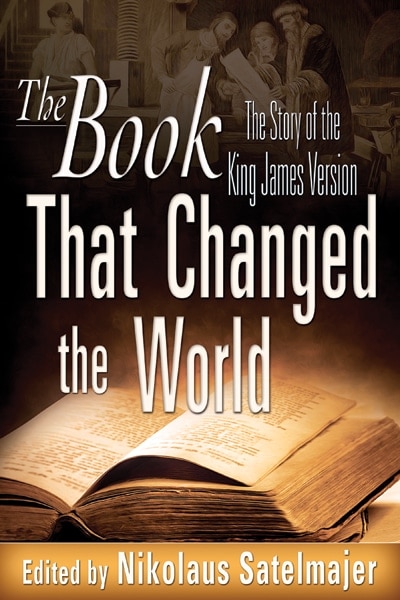
 The Book That Changed the World
The Book That Changed the WorldNickolaus Satelmajer, ed., Pacific Press Publishing Association, Nampa, Idaho, 2013, 160 pages, US$14.99, softcover. Reviewed by former Adventist Review editor William G. Johnsson.
Everyone who loves the Bible, especially the King James Version (KJV), will appreciate The Book That Changed the World, edited by Nickolaus Satelmajer. Interesting and informative, it ranges from history and theology to the Bible in digital culture and suggestions for personal study.
Satelmajer, previously editor of Ministry magazine, has gathered essays from a diverse group of Seventh-day Adventist scholars. Several of the chapters were originally prepared in 2011 in connection with the 400-year anniversary of the release of the KJV. To these Satel-majer has added new contributions that broaden the scope of the collection.
Satelmajer wrote the first chapter (on English Bibles prior to the KJV) and also the last (on personal study of the Bible). The other nine chapters take up the origins and making of the KJV (David Trim), its enduring influence (Bryan Ball), the influence of the works of Shakespeare and Donne on the English of the time (Cynthia Westerbeck), the KJV in an age of digital culture (Ingrid Satelmajer), its role in the African-American church (Willie Hucks II) and in the Adventist Church (Woodrow Whidden II), Ellen White’s relation to the KJV (Michael Campbell), the oral beauty of the KJV (Joseph Wheeler), and memorizing the Bible (Barry Black).
For me, the outstanding chapters in this excellent work were those by historian David J. B. Trim, “Taking ‘Pains in the House of God’: The Origins and Making of the Authorized Version”; and by Cynthia Westerbeck, “Contraries Meet in One: Shakespeare, Donne, and the King James Version.” Trim’s essay is a masterly piece of concise, well-documented research. It’s an essay to clip and keep. Westerbeck’s study sheds light on the marvel of the KJV—how some 47 translators, working individually and in groups, could produce a Bible of remarkable consistency, literacy, power, and enduring acceptance.
I enjoyed The Book That Changed the World and commend it highly. My only quarrel with it is that it does not tell the rest of the story—what happened after 1611. For there is another side. Although the KJV did indeed exert enormous influence for the good of many, myself included, in time it became the object of unwarranted veneration. The KJV is not a perfect translation, yet today many Christians, including some Adventists, argue vehemently for its exclusive use. They seem unaware that what they call the KJV is not the same as the original from 1611—it has been revised several times. Further, the passage of time has made much of its language obsolete and in some places misleading; ancient manuscripts discovered after 1611 have established that occasionally the KJV is based on spurious texts (for example, 1 John 5:7, 8).
Any celebration of the KJV should take note of this, the other side of its story. The Book That Changed the World acknowledges it, but not sufficiently.
These caveats aside, the KJV must be applauded. It is a pillar of both faith and language. This collection of essays makes a fitting tribute to this extraordinary book.
Toward the close of his essay Trim captures the story of the KJV poignantly: “Although its origins lay in the apparent whim of a notably authoritarian king and though it became the official version of the state church of a globe-spanning empire, its devotees are found all around the world, including among those who resisted British imperialism, both in America, Asia, and in Africa. What was the concept of a Calvinist king, the product of an emphatically Protestant group of translators, and intended to further the cause of the Reformation, is now widely seen as non-denominational. . . . The men who translated the [Authorized Version] took the best pains they could. This translation did justice to the sublime original and brought God closer to men and women” (pp. 48, 49).
BENTON, Taylor, J.—b. Feb. 11, 1920, Baltimore, Md.; d. Apr. 10, 2012, Westerville, Ohio. He served as principal and teacher in Ohio, Kentucky, New Jersey, Maryland, and Florida. He is survived by his wife, Ruth; two sons, John and Jeffrey; one daughter, Marsha Morgan; one sister, Nancy Monninger; six grandchildren; and one great grandchild.
JOHNSON, Herman J.—b. Aug. 4, 1926, Battle Creek, Mich.; d. Dec. 26, 2012, Altamonte Springs, Fla. He served as a certified registered nurse anesthetist in Florida Sanitarium and Hospital, and as a dean at Pacific Union College. He also served as a teacher at Andrews Academy, and as director of Counseling and Testing at Andrews University. He is survived by his wife, Wilma; one son, Richard; one daughter, Cheryl; one brother, Robert; one sister, Ingrid; five grandchildren; and two great-grandchildren.
MOREHEAD, Allen,—b. Dec. 4, 1924, Kinder, La.; d. Nov. 24, 2012, Lake Charles, La. He served the church as Sabbath school superintendent, deacon, treasurer, and elder. He is survived by his wife, Emma Lois; sons, Daniel Kerr, Kurt James, and Allen Joseph; daughter, Lori Ann; and several grandchildren.
PRENIER, Gordon,—b. Jan. 29, 1915 San Fernando, Calif.; d. Sept. 2012, Fletcher, N.C. He worked at the Review and Herald Publishing Association, as manager of the College Press in Jamaica, and as president of the New Salt Cays in Turks and Cacaos. He served the Southern Publishing Association, managed the press and taught printing at Mt. Vernon Academy, Ohio. He worked at Andrews University Press and Pacific Press Publishing Association. He was predeceased by his wife, Marjory. He is survived by his wife, Barbara; daughters, Betty Sue, Gloria Mae, and Carol Ann.